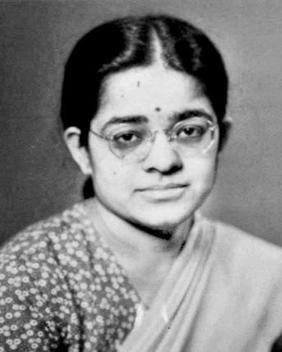Rajeshwari Chatterjee facts for kids
Quick facts for kids
Rajeshwari Chatterjee
|
|
|---|---|

Rajeshwari Chatterjee
|
|
| Born | 24 January 1922 |
| Died | 3 September 2010 (aged 88) |
| Nationality | Indian |
| Alma mater | University of Michigan Indian Institute of Science, Mysore University |
| Occupation | Professor, scientist |
Rajeshwari Chatterjee (born January 24, 1922 – died September 3, 2010) was an amazing Indian scientist and teacher. She made history as the very first woman engineer from Karnataka, a state in India. She worked at the Indian Institute of Science (IISc) in Bangalore. There, she became a professor and even led the Electrical Communication Engineering department.
Contents
Early Life and Learning
Rajeshwari Chatterjee was born in 1922 in Karnataka, India. She went to a special English school started by her grandmother, Kamalamma Dasappa. Her grandmother was one of the first women to graduate from Mysore University. She worked hard to help other women get an education, especially those who were widows or had been left by their husbands.
School and College Years
After finishing school, Rajeshwari thought about studying history. But she decided to focus on physics and mathematics instead. She studied at Central College of Bangalore. She earned two degrees in mathematics, a B.Sc. (Hons) and an M.Sc. She was the top student in both exams at Mysore University. She won special awards for her excellent grades, like the Mummadi Krishnaraja Wodeyar Award and the M.T. Narayana Iyengar Prize.
Starting Research at IISc
In 1943, after getting her M.Sc. degree, she joined the Indian Institute of Science (IISc) in Bangalore. She became a research student in the Electrical Technology Department. She wanted to work on communication technology.
She tried to work with a famous scientist named C.V. Raman. Some people say he didn't want her because she didn't have a physics degree. Others say he didn't like having women students.
Studying in the United States
After World War II, the Indian government offered scholarships for bright young scientists. This was to help India become independent from British rule. Rajeshwari applied for a scholarship in electronics. In 1946, she was chosen as a "bright student." She received money to study in the United States. She chose to go to the University of Michigan in Ann Arbor.
It was very hard for Indian women to study abroad in the 1950s. But Rajeshwari was determined. In July 1947, just one month before India became independent, she started her journey. She traveled to the USA on a ship that used to carry soldiers. The trip took 30 days!
In the US, she studied at the University of Michigan. She earned her master's degree in Electrical Engineering. Then, she trained for eight months at the National Institute of Standards and Technology in Washington D.C. She learned about radio frequency measurements.
After her training, she went back to the University of Michigan in 1949. She received a special scholarship called the Barbour scholarship. In early 1953, she earned her Ph.D. degree. Her professor, William Gould Dow, helped her with her research.
Career in India
In 1953, after getting her Ph.D., Dr. Chatterjee returned to India. She became a teacher at the Indian Institute of Science (IISc). She taught important subjects like electromagnetic theory, electron tube circuits, and microwave technology.
Building a Microwave Lab
In the same year, she married Sisir Kumar Chatterjee. He was also a teacher at IISc. After they got married, they worked together. They built a special laboratory for microwave research. This was the first time such research was done in India.
Later, Dr. Chatterjee was chosen to be the head of the Electrical Communication Engineering Department. She helped many students. She guided 20 students to get their Ph.D. degrees. She also wrote over 100 research papers and seven books.
After she retired from IISc in 1982, she continued to work on important projects. She helped with social programs, like the Indian Association for Women's Studies.
Books by Rajeshwari Chatterjee
- Elements of Microwave Engineering
- Antenna Theory And Practice
- A Thousand Streams: A Personal History
- Dielectric And Dielectric Loaded Antennas
- Advanced Microwave Engineering: Special Advanced Topics
- Vasudhaiva Kutumbakam: The Whole World Is But One Family: Real Stories of Some Women and Men of India
- Antennas for Information Super Skyways: An Exposition on Outdoor and Indoor Wireless Antenna, co-authored by Perambur S. Neelakanta
Personal Life and Family
Rajeshwari's father, B.M.Shivaramajah, was a lawyer. Her grandmother, Kamalamma Dasappa, was one of the first women to graduate from Mysore. Rajeshwari married Sisir Kumar Chatterjee in 1953. They had a daughter named Indira Chatterjee. Indira is now a professor of Electrical and Biomedical Engineering at the University of Nevada, Reno in the USA.
Awards and Honors
Rajeshwari Chatterjee won many awards for her amazing work in microwave engineering. Here are some of them:
- Mummadi Krishnaraja Wodeyar Award for being first in her B.Sc. (Hons) class.
- M T Narayana Iyengar prize and the Waters Memorial prize for being first in her M.Sc. class.
- Mountbatten prize for writing the best paper from the Institute of Electrical and Radio Engineering (UK).
- J.C Bose Memorial prize for the best research paper from the Institution of Engineers.
- Ramlal Wadhwa Award for her excellent research and teaching from the Institute of Electronics and Telecommunication Engineers.

